“The Blues in Venice” by Shandra Dohoney

“A View of Valentino” by Emily Favret
This blog documents the experiences of students currently studying at the Umbra Institute in Perugia, Italy, offering an account of their day-to-day experiences, extra- and co-curricular activities, and special events. We hope you gain some insight into what adventures Umbra students find outside the classroom during their semester in Perugia, a medieval town in the mountains of Umbria. Cheers!
“The Blues in Venice” by Shandra Dohoney

“A View of Valentino” by Emily Favret
 Although the fall break week provided plenty of time to travel throughout Europe and see the sights, Sarah Murphy and I wanted to spend our week off getting to know another area of Italy personally, practice our Italian, and spend as little euro as possible. After searching through several possible WWOOFing farms, deciding upon the hopefully still- moderately-weathered-Sicilia was easy. Our destination, Villa Del Bosco, roughly 2 km from the small town of Calatafimi, (in the region of Trapani) was in the middle of their olive harvest and in need of willing workers.
Although the fall break week provided plenty of time to travel throughout Europe and see the sights, Sarah Murphy and I wanted to spend our week off getting to know another area of Italy personally, practice our Italian, and spend as little euro as possible. After searching through several possible WWOOFing farms, deciding upon the hopefully still- moderately-weathered-Sicilia was easy. Our destination, Villa Del Bosco, roughly 2 km from the small town of Calatafimi, (in the region of Trapani) was in the middle of their olive harvest and in need of willing workers.
After 24 hours of continuous travel, we arrived, munched down a quick lunch and tramped out about one kilometer to the near by olive groves. Villa Del Bosco has over 1000 olive trees and while I’d love to say we got to all 1,000, we probably only did 799 (something like that) . Although it rained four out of the seven days, forcing us to stay inside and clean house, we harvested olives for about 18 hours total, yielding roughly 75 average sized bottles of the freshest, greenest most delicious olive oil known to man.

Due to a number of other farms around the area, we would wake up to surprises, such as newly pressed wine, abowl of fresh picked tomatoes or chicken eggs still with a few feathers on, on the table down stairs each morning. The Villa Del Bosco also doubles as an agriturismo and we cooked for an average of 8 people per meal! Thank goodness for the Sicilian cookbooks that were around the house, as well as native Sicilians who treated us to homemade snail soup one night. It was extremely relaxing, we would wake up around 9 each day, stroll out to the olive grove (if it wasn’t raining) work for about 3 hours, come inside, cook a huge Italian pranzo (noon meal), take a siesta until 3:30 then head back out to the grove and pick till 6-ish. Coming inside, we would take a quick snack, lounge by the fire and read or talk with the other workers until we started to make dinner around 8-ish.

We either retired early to bed, traveled a bit to relax in the hot springs, walk around the mountains in full moon light or bake apple turnovers and other sweet treats. We didn’t have to pay for any ingredients, food or our beds for 7 days and nights! It was certainly an interesting, rewarding experience filled with trials (dealing with Italians who did not exactly appreciate or understand American cooking, a lack of running water for a day or so), successes (picking over fifteen 25 kg buckets of olives in thick mud and the Sicilians being sad we wouldn’t be there to make chocolate chunk cookies again) and a week of stories that make us laugh (a characteristic 45 year old German woman misunderstanding our English, hearing string cheese as chicken cheese) and wish we could go back (sleeping in until 9 every day AND taking a nap for at least an hour a day). I would do it again in a heartbeat and wouldn’t have changed my week in Sicilia for all the road trips throughout Europe.
Post by Erica Mouch
Erica Mouch, the author of this blog, is a student from Elon University studying at The Umbra Institute this semester. She also writes for Cafeabroad.com
 When most people think of Seattle, images of a growing seaport might come to mind, of streets dotted with Starbucks, of Microsoft and Boeing. It seems strange, therefore, that the largest city in the Pacific Northwest region of the United States would call Perugia, an ancient and relatively small Etruscan city known for chocolate and its historical character, its sister. Certainly, at least on paper they have virtually nothing in common. Yet this is not the point of the “sister-city philosophy”. In fact, it was the very differences of Seattle and Perugia that brought them together in the first place, a refreshing desire for each city’s citizens to learn more about a completely foreign culture.
When most people think of Seattle, images of a growing seaport might come to mind, of streets dotted with Starbucks, of Microsoft and Boeing. It seems strange, therefore, that the largest city in the Pacific Northwest region of the United States would call Perugia, an ancient and relatively small Etruscan city known for chocolate and its historical character, its sister. Certainly, at least on paper they have virtually nothing in common. Yet this is not the point of the “sister-city philosophy”. In fact, it was the very differences of Seattle and Perugia that brought them together in the first place, a refreshing desire for each city’s citizens to learn more about a completely foreign culture.
The story of the sister cities has come a long way from its initial founding in September of 1991, when the mayors of Seattle and Perugia, Norman Rice and Mario Valentini, signed a formal pact of friendship.
Yesterday, some fifteen years later, the president of the Seattle-Perugia Sister City committee, Mike James, presented Laura Noges, a native of Seattle and current Umbra Student, with the inaugural Sister City Scholarship. Those in attendance, including Academic Director of the Umbra Institute, Dr. Carol Clark, and Daniela Borghesi of the Office of International Relations of Perugia, met in the Sala  Rossa on Perugia’s Via dei Priori where Laura graciously received her scholarship. Ms. Noges was also gifted a pin reserved for Perugia’s honorary citizens. Shortly after, she happily accepted Mike James’ invitation to become a future member of the Sister Cities association.
Rossa on Perugia’s Via dei Priori where Laura graciously received her scholarship. Ms. Noges was also gifted a pin reserved for Perugia’s honorary citizens. Shortly after, she happily accepted Mike James’ invitation to become a future member of the Sister Cities association.
The Umbra Institute offers two partial scholarships annually, one each semester, to residents of Seattle or Grand Rapids, Perugia’s other sister city.
The Umbra Institute warmly congratulates Laura Noges, whose example will hopefully inspire others to engage in crucially important dialogue between cultures. Well done, Laura!
After reviews, papers, project deadlines, late nights at the library for last-minute cramming, yesterday marked the end of mid-terms. Fall Break 2007 has officially begun!
While some students plan to stay in Italy and scour the must-see sights, others have spend the better part of October organizing, plotting and artfully contriving ways of seeing as much of Europe as they possibly can in one week’s time.
With their passport and Euro rail passes in hand, along with an assortment of low-cost airlines to choose from, students take full advantage of having Europe at their doorstep. This year’s most popular destinations among students include Barcelona, Paris, Dublin, Brussels,Prague and Budapest. A few students have even left directly from Perugia on Ryan Air’s two-hour direct flight to London.
Besides air transportation, some students have chosen to see Europeby hitting the high seas of the Mediterranean. In and out of the ports ofItaly, Greece, Turkey, Croatia and Spain students sample, savor and relish the best of what each country has to offer.
However students choose to spend their break—plane, train or by boat—we wish them safe and happy trails!
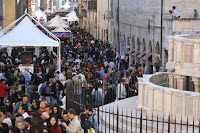 Chocolate has a long association with Perugia, from the early days a hundred years ago when the Perugina chocolate factory started here up until now. This year’s edition of the famous Eurochocolate festival opened Saturday morning with perfectly limpid skies and just a bit of wind. Accents from all over Italy (Bergamo, Naples,
Chocolate has a long association with Perugia, from the early days a hundred years ago when the Perugina chocolate factory started here up until now. This year’s edition of the famous Eurochocolate festival opened Saturday morning with perfectly limpid skies and just a bit of wind. Accents from all over Italy (Bergamo, Naples, Venice) are to be heard in the streets as people search for just the right chocolate.
Venice) are to be heard in the streets as people search for just the right chocolate.
One of the perennial highlights is the choc-sculpture contest, where artists from Perugia compete in carving their masterpieces from huge blocks of dark chocolate, with the crowd being treated to the pieces chipped away. This year’s edition even had a socially responsible aspect, with the Equochocolate stand in the former papal fortress distributing information about fair trade chocolate. For a look at the festival, paste this link www.comune.perugia.it/livecams/Priori.htm into your browser for the 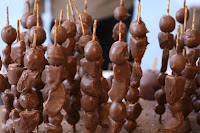 city’s webcam.
city’s webcam.
 Giuseppe, Antonio and Gennaro La Bufala (otherwise known as the “Buffalo Brothers”) were born in Eboli, a small town tucked away in the province of Salerno known for its smiling faces and charming atmosphere.
Giuseppe, Antonio and Gennaro La Bufala (otherwise known as the “Buffalo Brothers”) were born in Eboli, a small town tucked away in the province of Salerno known for its smiling faces and charming atmosphere.
Theirs is a classic story… Having spent their youth working for their father, a mozzarella producer, the Buffalo brothers found themselves at an existential impasse, one of those proverbial forks in the road: Continue on as they had been? Or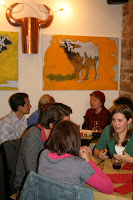 leave everything behind and give in to the strong pull of adventure?
leave everything behind and give in to the strong pull of adventure?
Luckily, the brothers took the second road, each going in a separate direction. For a time, anyway.
In 2000, Gennaro decided to open a pizzeria in Milan, with the hope of giving northern Italians the phenomenal taste of Napolitano pizza. And, not surprisingly, his brothers quickly joined him (Antonio’s Flamenco school in Madrid didn’t quite work out) to pursue what became their true life’s calling.
 the highest standards set forth by generations of southern Italian pizza makers. In fact, the only pizza makers you’ll find in a Fratelli la Bufala hail from Napoli.
the highest standards set forth by generations of southern Italian pizza makers. In fact, the only pizza makers you’ll find in a Fratelli la Bufala hail from Napoli.Several weeks ago, the brothers opened another pizzeria, this time in Perugia.
It was thus under the arches of an old-stone-building-turned-pizzeria that the Umbra Institute held this week’s Tandem, the smells of pizza and apertivi drifting amongst Italians and Americans keen on making friends while sharpening their linguistic faculties. It was a grand success, so much so that many students were prompted to stay after Tandem had finished, trying other dishes bearing the provincial culinary mark of Giuseppe, Antonio and Gennaro La Bufala.
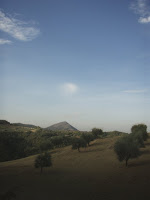 This past weekend Cynthia Clough, professor of Italy of the Imagination: Creative Writing, took one of the sections of her class for a retreat in the Umbrian countryside. The first stop was not rural, actually, but rather the Umbrian city of Gubbio. Students basked in the sun at the well-preserved Roman ampitheater and took the ski lift-like cabinovia to the top of the hill to see the Church of Sant’Ubaldo (Gubbio’s patron saint). An ample meal of gnocchetti, oven-roasted potatoes, and veal gave the students the energy their brains needed for the afternoon’s activities, which were at an agriturismo (farmhouse and rural hotel) near Perugia.
This past weekend Cynthia Clough, professor of Italy of the Imagination: Creative Writing, took one of the sections of her class for a retreat in the Umbrian countryside. The first stop was not rural, actually, but rather the Umbrian city of Gubbio. Students basked in the sun at the well-preserved Roman ampitheater and took the ski lift-like cabinovia to the top of the hill to see the Church of Sant’Ubaldo (Gubbio’s patron saint). An ample meal of gnocchetti, oven-roasted potatoes, and veal gave the students the energy their brains needed for the afternoon’s activities, which were at an agriturismo (farmhouse and rural hotel) near Perugia.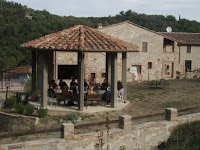
After that session students were once again treated to a full dinner of organic food that was mostly produced on that very farm (among others, sausages, veal, and honey). The second day consisted of other writing exercises (noticeably inspired by the beautiful panoramas) and a walk around the agriturismo’s property, a walk which included spectacular views from the hilltop olive orchard and the attention of a curious herd of sheep. Not even a grumpy bus driver on the return trip could spoil the magic of the Umbrian countryside, and Professor Clough commented that she would be eager to see the contents of Wednesday’s assignments after the weekend of scenery and exercises.
 A comedic mixture of love, laughter and jealousy kept Umbra students tied to their seats last night in Perugia’s very own Teatro Morlacchi. Under magnificent 18th century frescoes and a charming chandelier, a rapt audience listened as an ensemble cast of tenors, baritones, altos and the like sang The Barber of Seville.
A comedic mixture of love, laughter and jealousy kept Umbra students tied to their seats last night in Perugia’s very own Teatro Morlacchi. Under magnificent 18th century frescoes and a charming chandelier, a rapt audience listened as an ensemble cast of tenors, baritones, altos and the like sang The Barber of Seville.
For many, exposure to this famous “opera buffa” and its enchanting lyrics has beenlimited to the liberal interpretations of Warner Bros. Perhaps you may recall the “Rabbit of Seville”, staring Bugs Bunny and Elmer Fudd?
Needless to say, what students witnessed last night cast a long shadow over the beloved Looney Tunes of our childhoods, moving the audience to a standing ovation and cries of “Bravo, BRAVO!” Indeed, after spot-on portrayals of the dashing count Almaviva, or the lovely Rosina and her cunning and jealous guardian Bartolo, it would have been a crime not to applaud with the utmost vigor!
And we couldn’t forget Figaro, that baritone barber of Seville himself, that grand trickster and omnipresent weaver of webs. In fact, students were left wondering whether it was the Umbra Staff or the sly, yellow clothed barber who organized a tasty apertivo before the red curtain took to the ceiling.
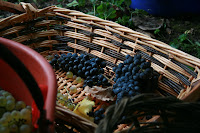 Have you ever seen that episode of “I Love Lucy” where Lucy gets into the vat of grapes and stomps? Many Umbra students had, but few thought they would ever take the plunge into grapes with their feet
Have you ever seen that episode of “I Love Lucy” where Lucy gets into the vat of grapes and stomps? Many Umbra students had, but few thought they would ever take the plunge into grapes with their feet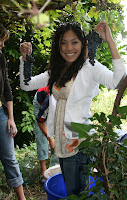 – though that’s exactly what they did this weekend. In addition to Umbra’s winetasting classes (which talk about wine from bottle to stomach), Umbra also has a winemaking class (covering wine from grape to bottle).
– though that’s exactly what they did this weekend. In addition to Umbra’s winetasting classes (which talk about wine from bottle to stomach), Umbra also has a winemaking class (covering wine from grape to bottle).
Saturday morning students met staff member Zach Nowak and took a short walk to the vineyard that he takes care of (with other staff member Dave Dickson) for their adventure in winemaking. The workshop started with a short lesson on the biochemistry of fermentation (with an aside to distillation) and some notes on pruning and grape selection, followed by the assignment of tasks: cleaning and washing the antique wooden press, cutting the bunches from the vines down in the vineyard, and finally, the Crush.
In a practically Biblical scene, students washed each other’s feet before taking the plunge into the cold grapes, w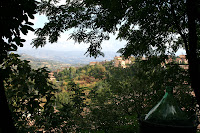 hose juice squirted out into the bucket. The juice was drained off and the pulp added to nylon bags that were then passed to the press workers for extra pressing. After all the grapes had been pressed the students went down to the fire pit in the midst of the grape vines and had a classic Umbrian agricultural worker’s lunch: bruschetta with only extra-virgin olive oil and salt, and tasty Umbrian sausages grilled on an open fire (as well as potatoes, marinated eggplant, and bell peppers
hose juice squirted out into the bucket. The juice was drained off and the pulp added to nylon bags that were then passed to the press workers for extra pressing. After all the grapes had been pressed the students went down to the fire pit in the midst of the grape vines and had a classic Umbrian agricultural worker’s lunch: bruschetta with only extra-virgin olive oil and salt, and tasty Umbrian sausages grilled on an open fire (as well as potatoes, marinated eggplant, and bell peppers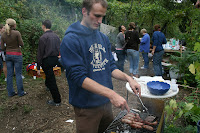 for herbivores). Staff members Tyler Pace (himself a Winemaking Workshop alum from Fall 2005) and Mauro Renna made a timely appearance for cooking lunch.Six weeks from now the students will return to the vineyard for the festival of San Martino to try their new wine, along with roasted chestnuts. Updates to follow on November 11th!
for herbivores). Staff members Tyler Pace (himself a Winemaking Workshop alum from Fall 2005) and Mauro Renna made a timely appearance for cooking lunch.Six weeks from now the students will return to the vineyard for the festival of San Martino to try their new wine, along with roasted chestnuts. Updates to follow on November 11th!